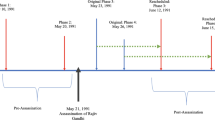Abstract
As in large elections, substantialabstention is frequently observed inlegislative assemblies. This paper analyzesroll call votes from the third and fourthlegislatures (1989–1999) of the EuropeanParliament to test predictions from threetypes of theories of abstention: (1)decision-theoretic approach of RationalChoice theory, (2) game-theoretic approachof Rational Choice theory, and (3) theSwing Voter’s Curse theory. The resultsindicate that closeness significantlydecreases the rate of abstention. Thefindings also show that an increase in theprobability of being in the majorityincreases turnout. Overall, findings aresupportive of the decision-theoreticapproach of Rational Choice theory butnot of the game-theoretic approach toabstention or the Swing Voter’s Cursetheory.
Similar content being viewed by others
References
Aldrich, J.H. (1993). Rational choice and turnout. American Journal of Political Science 37: 246–278.
Cohen, L. and Noll, R. (1991). How to vote, whether to vote: Strategies for voting and abstaining on congressional roll calls. Political Behavior 13: 97–127.
Chamberlain, G. and Rothschild, M. (1981). A note on the probability of casting a decisive vote. Journal of Economic Theory 25: 152–162.
Corbett, R., Jacobs, F. and Shackleton, M. (1995). The European Parliament. Cartermill International.
Downs, A. (1957). An economic theory of democracy. New York: Harper and Row.
Feddersen, T.J. and Pesendorfer, W. (1996). The Swing Voter’s Curse. American Economic Review 86: 408–424.
Ferejohn, J. and Fiorina, M.P. (1974). The paradox of not voting: A decision theoretic analysis. American Political Science Review 68: 525–536.
Forgette, R. and Sala, B. (1999). Conditional party government and member turnout on Senate recorded votes, 1873–1935. Journal of Politics 61: 467–484.
Greene, W.H. (1996). Econometric analysis. Prentice-Hall, Inc.
Hix, S., Raunio, T. and Scully, R. (1999). An institutional theory of behaviour in the European Parliament. EPRG Working Paper, No. 1.
Kahneman, D. and Tversky, A. (1979). Prospect theory: An analysis of decision under risk. Econometrica 47: 263–291.
Lott, J.R. Jr. (1990). Attendance rate, political shirking, and the effect of post-elective office employment. Economic Inquiry 38: 133–150.
Myerson, R.B. (1994). Population uncertainty and Poisson games. CMSEMS Discussion paper No. 1120 R. Northwestern University.
Noury, A.G. (2002). Ideology, nationality and Euro-parliamentarians. European Union Politics 3: 33–58.
Noury, A.G. and Roland, G. (2002). More power to the European Parliament? Economic Policy 35: 281–319.
Palfrey, T.R. and Rosenthal, H. (1983). A strategic calculus of voting. Public Choice 41: 7–53.
Palfrey, T.R. and Rosenthal, H. (1985). Voter participation and strategic uncertainty. American Political Science Review 79: 62–78.
Poole, K.T. and Rosenthal, H. (1997). Congress: A political-economic history of roll call voting. Oxford: Oxford University Press.
Rabin, M. and Thaler, R. (2001). Anomalies: Risk aversion. Journal of Economic Perspectives 15: 219–232.
Riker, W.H. and Ordeshook, P.C. (1968). A theory of the calculus of voting. American Political Science Review 62: 25–42.
Rothenberg, L. and Sanders, M. (2000a). Legislator turnout and the calculus of voting: The determinants of abstention in the U.S. Congress. Public Choice 103: 249–270.
Rothenberg, L. and Sanders M. (2000b). Modeling legislator decision-making: An historical perspective. Unpublished paper.
Scully, M.R. (1997). Policy influence and participation in the European Parliament. Legislative Studies Quarterly 12: 233–252.
Zellner, A. (1962). An efficient method of estimating seemingly unrelated regressions and tests of aggregation bias. Journal of American Statistical Association 57: 500–509.
Zupan, M. (1991). Local benefit-seeking and national policymaking: Democrats vs. republicans in the legislature. Public Choice 68: 245–258.
Author information
Authors and Affiliations
Rights and permissions
About this article
Cite this article
Noury, A.G. Abstention in Daylight: Strategic Calculus of Voting in the European Parliament. Public Choice 121, 179–211 (2004). https://doi.org/10.1007/s11127-004-9221-8
Issue Date:
DOI: https://doi.org/10.1007/s11127-004-9221-8




